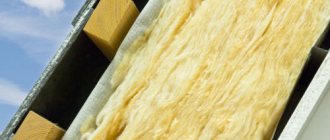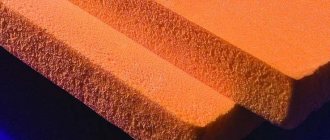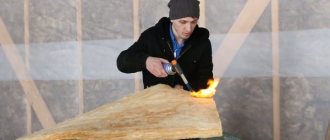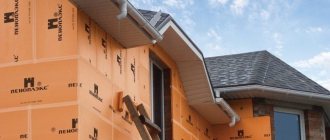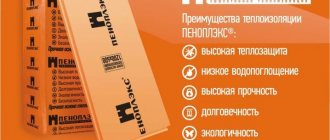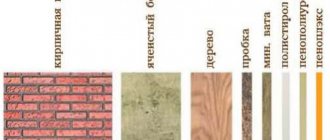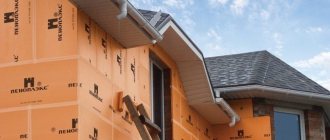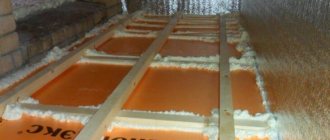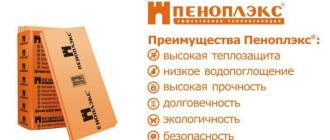No construction is complete without the use of insulating materials. Houses are often insulated using foamed polymers, the production method of which raises controversy about fire safety. Everyone knows about expanded polystyrene, synonymous with the brand Penoplex; Whether this material burns or not worries many owners who choose insulation for their home. Let's take a closer look at the properties of expanded polystyrene (EPS), examine its flammability and find out how dangerous it is in a fire.
Opinions about the dangers of polystyrene foam insulation vary widely Source lalafo.com
About the material
Expanded polystyrene belongs to foam plastics, a class of materials that are foamed (cellular) plastic masses. It was first produced on an industrial scale in Germany in 1937; in the USSR production began two years later.
The raw materials for EPS are polystyrene and other polymers. The technological process is based on saturating the polymer mass with a foaming agent, followed by heating the mass with steam. As a result, polystyrene granules increase in volume, fill the mold and are sintered, forming the shape of the finished product.
There is another technology when processes take place at elevated temperature and pressure. The foamed mass is squeezed out of the extruder, and the material obtained by extrusion is called extruded (or extruded) polystyrene foam. Both materials are synthetics, which are flammable.
The final stage of production of EPS boards Source piramida-stroi.ru
How is foam plastic used?
You may remember from your school chemistry course that any chemical reaction, including polymerization, can occur in the reverse order, the so-called decomposition of molecules. This means that harmful substances that once turned into safe solids can again be “free” in the form of vapors. For example, the release of substances such as benzaldehyde, formaldehyde and styrene can be harmful to health. But, of course, this requires certain conditions. Therefore, never violate the instructions for installing polystyrene foam. The two main enemies of polystyrene foam are:
- Ultra-violet rays;
- Heat.
Degrees of flammability of building materials
Homeowners make their choice of material for home insulation based on various considerations. Some, with a limited budget, focus on cost; for others, simple installation is important. However, everyone, one way or another, pays attention to the fire resistance and environmental friendliness of the construction material.
On the Internet there are different, often mutually exclusive, opinions about the flammability of expanded polystyrene and penoplex in particular. To figure out where the truth lies, you need to start with the official classification of flammability.
Flammability classes (as well as methods for testing construction mats for susceptibility to fire) are established on the basis of documentation GOST 30244-94. The classification is used in the future to ensure fire safety. Building materials are exposed to fire and, depending on their behavior, are divided into two types: combustible (G) and non-combustible (NG). Combustible construction mats, in turn, form the following groups:
- Low flammability (G1). Such materials do not burn (extinguish) on their own, the degree of destruction does not exceed 20%, and the flue gases do not heat above 135°.
Fire hazard properties of building materials Source wp.com
- Moderately flammable (G2). Materials of this group are capable of burning on their own for no more than 30 seconds, while they are destroyed by fire by no more than 50%, and the gases do not heat above 235°.
- Normally flammable (G3). No more than 300 seconds pass before attenuation, while the gases have time to heat up to a maximum of 450°, and the material has time to collapse by 50%.
- Highly flammable (G4). Self-combustion lasts longer than 5 minutes, other parameters exceed the values of the previous paragraph.
Building materials are also classified according to other properties, for example, flammability, smoke-generating ability, and toxicity of combustion products. Each of these properties is divided into groups. For example, the flammability of building materials is divided into the following categories: hardly flammable (B1), moderately flammable (B2), flammable (B3).
EPS without fire retardant additives is a highly flammable material Source pro-uteplenie.ru
See also: Catalog of companies that specialize in home insulation
Test results
Most of the tests to which penoplex was subjected confirm the fire hazard. The test results are as follows:
- in the absence of a constant source of fire, the insulation begins to self-extinguish;
- deformation of the heat insulator appears only in the place where it was exposed to fire;
- the maximum height of the flame fades during the first 5 seconds, then the burning slows down, the material begins to smolder;
- the insulation is toxic; it emits toxic smoke.
The fire hazard of polystyrene insulation lies in two aspects: the danger of combustion itself and the release of toxic substances. The second factor has a greater impact, since statistics report that only 1/5 of those injured in fires were victims of fire. According to the results of tests carried out at the VNIIPO of the Ministry of Internal Affairs of the Russian Federation, the toxicity of the samples is close to the limit values for the class of highly hazardous materials. This fact confirms the requirements for this heat insulator in some European countries. There, a penoplex thickness of 35 mm is defined as the maximum. In Russia, the requirements are less stringent; in some facilities, insulation reaches 30 cm.
Flammability degree of PPS
Stories about non-flammable polystyrene foam do not correspond to reality, as evidenced by the G4 flammability class assigned to it. And, although it will not ignite from a burning cigarette butt, sparks from a sharpening tool or a red-hot knife blade, the cause of ignition may well be a lit match, the flame of a blowtorch or a spark from an autogen. The combustion of EPS is described by the following characteristics:
- The ignition temperature lies in the range of 210-440°C, the difference is determined by the composition of a particular modification of the synthetic.
- The flame temperature rises to 1200°C in a short time, so the material can intensify the fire.
- Combustion is accompanied by the formation of toxic smoke, the composition of which also depends on impurities. The volume of toxic products released (hydrogen cyanide, hydrogen bromide) is 36 times greater than the volume of emissions from burning wood.
Expanded polystyrene of flammability class 4 suffers from all these properties; for obvious reasons, it does not have approval certificates for use in construction.
If you remove the source of the flame, the fire goes out. Source ytimg.com
The answer to the question whether penoplex burns will also be positive, although this property is assessed according to class G3-G4. Many manufacturers reduce the degree of flammability and combustion temperature by adding fire retardants; There are additives that reduce the intensity of smoke formation. In most cases, the effect is achieved by replacing the gas mixture during the production process: the volume is increased not with fuel, but with carbon dioxide.
Thermal conductivity
EPS and EPS have low, and therefore good, thermal conductivity. The extruder, due to its denser structure, is slightly ahead in this parameter. A 50 mm sheet insulates a room better than a half-meter thick concrete wall. This is an effective material, on par with mineral wool.
Note: UV protection and adhesion
Polystyrene foam is afraid of ultraviolet radiation. It must be covered with another material on top: plaster, if we are talking about a facade, or a roofing covering together with a waterproofing membrane, if the roof is insulated.
EPS and EPS are very smooth, so in order to improve the surface in terms of adhesion, before applying the glue, you need to damage the top layer with very rough sandpaper or scratch it with a hacksaw. Otherwise, over time, the plaster will slip and fall off.
Another reliable option is to glue a reinforced mesh onto the insulation with alkaline glue, and then apply plaster on it.
About labeling and legislative subtleties
Until 2009, flammable PPS, to which flame retardants were added, received the G1 marking. In May 2009, federal law FZ-123 “Technical Regulations on Fire Safety Requirements” came into force. He changed the method by which building materials were distributed into flammability groups.
Based on the totality of their characteristics, all polystyrene-based insulation materials are now classified no higher than G3. This is due to the fact that, according to the new rules, materials of groups G1-G2 cannot form melt drops.
Expanded polystyrene boards are approved for use in construction Source 1-teplodom.ru
Let's summarize
If you want to buy expanded polystyrene boards for building a house, you should understand that the material does not have high fire resistance. Or you will have to purchase expensive, but fire-resistant insulation. This applies to a greater extent to the upper structures: the attic, attic and roof. When purchasing, ask the seller for a certificate, GOST compliance and technical specifications. You can reduce the risk by observing fire safety measures: the insulation should be located far from the source of fire, for example, a fireplace; you should not use this heat insulator in saunas and baths.
How dangerous is penoplex?
Misunderstandings often arise between sellers and buyers. When a buyer is interested in whether penoplex is a flammable material or not, the seller can say that the insulation is a fire-resistant building material. He will be right if the slabs belong to classes G1-G3, and a fire-retardant impregnation is added to them, making the material self-extinguishing.
However, even in this case, the polymer will not withstand fire: the surface will melt and combustion products will enter the air. And, although the technology for producing EPS has been improved, and flammable gas has been replaced with carbon dioxide, the health hazard still remains. When burning, among other things, soot and hydrogen chloride are released, and their inhalation can cause an attack of suffocation, and in rare cases, pulmonary edema.
Therefore, foamed EPS can be classified as non-flammable only conditionally, implying its good fire resistance. Buyers often take the name literally and believe that the seller is deceiving them, although they interpret the same concept in different ways.
Expanded polystyrene emits smoke in any case Source yandex.net
“Velit” insulation made of porous concrete D-140
A very good and promising heat insulator, which is used to insulate house facades, flat roofs, floors, and ceilings. What does he imagine himself to be? Velit is porous concrete D-140 (for understanding, I can say that one cubic meter of this material weighs only 140 kg) is non-flammable.
It does not have a flammability class, it is simply not standardized by class, it is NG, which means non-flammable. Since this insulation is porous concrete, in principle it cannot burn, and there is nothing you can add here.
Briefly about the main thing
Artificial materials always raise concerns in terms of their fire safety. The danger that a particular building material can pose is regulated by regulatory documents, and each building material is assigned certain characteristics: the degree of flammability, toxicity of combustion products, smoke-generating ability.
Initially, EPS had a maximum degree of flammability, but then they began to reduce it using fire retardant additives. Modified (self-extinguishing) insulation is allowed to be used in construction, provided that the installation rules are followed. But even in this case, the surface of the polymer melts under the influence of fire, and toxic substances enter the air.
Description
Density
High-quality EPS has a homogeneous structure and closed pores of a much smaller size than conventional polystyrene foam (no more than 0.2 mm). Due to its increased compressive density, EPS can be used where foam plastic is too soft. Extruded polystyrene foam can withstand a load of 35 tons per 1 m2!
Installation work
Another advantage that this material structure provides is the ability to process it comfortably. Many people know how difficult it was to cut foam plastic. The balls crumbled, scattered and became magnetized to hands, tools and surfaces. And even with careful handling, the slab could crack and break in the wrong place.
House insulation with Penoplex
Extruded polystyrene foam is free of all these disadvantages. It is easy to cut with a regular hacksaw. The cut is precise and even. And the slabs are laid directly on the base - no additional layers of steam and waterproofing are required. The joints are sealed with polyurethane foam. EPS does not emit toxic substances or unpleasant odors. Working with it does not require special equipment for installers.
Moisture absorption
The dense structure increased the moisture resistance of the material (against the background of vulnerable mineral wool, water absorption of 0.2 looks like an error). In the first 10 days, the side cells on the cut collect a minimal amount of moisture. Then water absorption stops, water does not pass inside.
Thermal conductivity
In the battle to retain heat, even a slight difference in thermal conductivity matters. For different brands of expanded polystyrene, this figure ranges from 0.037 to 0.052 W/(m* °C). Extruded polystyrene foam has an indicator of 0.028 - 0.03 W/(m* °C)!
Chemical resistance
XPS has proven to be resistant to:
- various acids (organic and not);
- salt solutions;
- ammonia;
- cement and concrete;
- lime;
- alkalis;
- alcohol dyes, alcohol;
- carbon dioxide, oxygen, acetylene;
- freons (fluorinated hydrocarbons);
- paraffin;
- water and water-based paints;
- bacteria and fungi.
Other properties
The thickness of the produced slabs can be from 2 to 12 cm.
For ease of installation, three types of edges are available:
- Straight.
- With the selected quarter (marked with the letter S).
- Tenon - groove (letter N on the marking).
The outer surface can be smooth or corrugated (indicated by the letter G on the marking).
The color range of extruded polystyrene foam is varied. There are no uniform standards yet, so each manufacturer produces slabs of different sizes, thicknesses and different colors to indicate different quality EPS.
The properties of EPS do not change even after 1000 freezing-thawing cycles, or after prolonged immersion in water. Extruded polystyrene foam remains unchanged even in conditions of -60 +85 °C!
Orange slabs
Cons and weaknesses:
- Penoplex is vulnerable to solvents, some gases (methane), petroleum jelly, tar, gasoline, oil and fuel oil.
- Susceptible to destruction upon contact with polyvinyl chloride (siding).
- Flammability. It corresponds to the level of flammability of wood, but all foam plastics emit toxic substances when melted that suffocate a person faster than carbon monoxide.
- The material must be protected from direct exposure to ultraviolet radiation (not used open).
- There are temperature restrictions when insulating baths, saunas and fire pits. The surface should not be heated above +75 °C.
- Just like polystyrene foam, extruded polystyrene foam can be damaged by rodents. They don't eat it, but grind it up and build nests in it.
There are no ideal materials, therefore, knowing about its shortcomings, you need to be able to adjust technologies to suit them. For example, in order to protect residents in case of fire, it is not recommended to use EPS for internal insulation of ceilings, and plastering should be done on top of the insulation layer.
To protect the wall from rodents, Penoplex slabs can be covered with fine mesh.
